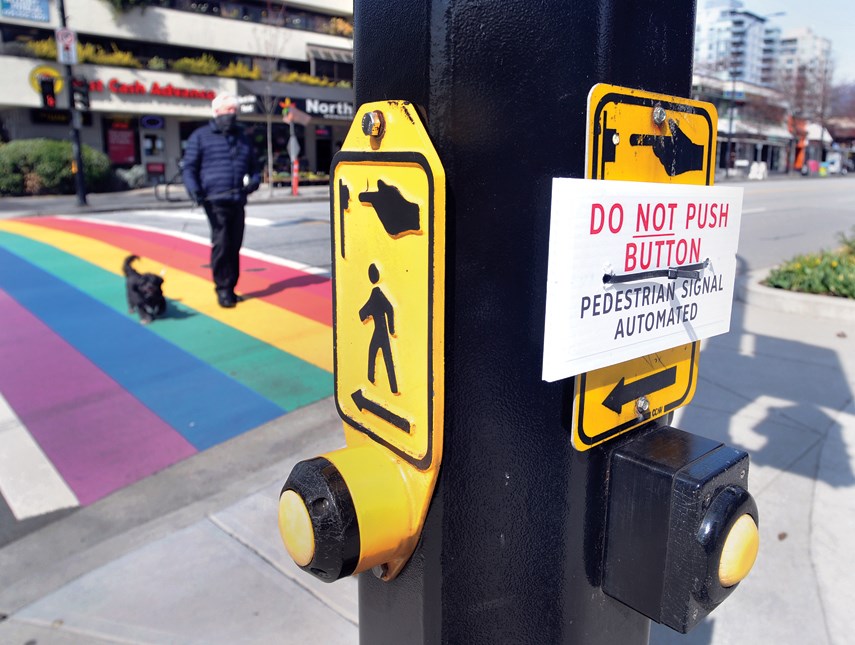Thanks to the COVID-19 pandemic, people crossing busy streets across the North Shore will no longer have to push buttons to allow safe passage through the intersection.
The City of North Vancouver’s traffic signals were already programmed to include a longer “walk” phase during the daytime, but that is now being extended.
“In response to COVID-19, we’ve automated pedestrian signals at 14 intersections along Lonsdale Avenue and Marine Drive to provide a pedestrian crossing phase 24 hours a day to support physical distancing and reduce the need to touch common surfaces,” said Stephanie Smiley, city spokeswoman.
West Vancouver followed soon after, turning off its pedestrian-activated walk signals – with the exception of 11th, 18th, 19th, 20th and 31st streets, as those traffic signals will only cycle when someone pushes the button.
The District of North Vancouver has implemented default pedestrian crossing cycles at 20 intersections in Lynn Valley, Edgemont, Delbrook, Seymour and Lynn Creek.
Brent Toderian, of Toderian UrbanWorks, said the virus is now making cities act on something he’s been advocating for a long time.
“Touching things that other people have touched frequently is [already] problematic. Suddenly you have an urgency to the debate,” he said.
The very existence of “beg buttons” is a throwback to old planning habits in which the convenience of drivers was given priority over people on foot.
“They're called ‘beg buttons’ as a pejorative because they put pedestrians in the position of having to beg for access to the other side of the street,” he said. “It suggests the pedestrian is in a secondary, at best, position – an afterthought.”
The buttons also present practical problems. They can be difficult or impossible to access for people with mobility challenges. They can be easy to miss, and even after the button has been pushed, it often takes a full cycle of the light before the “walk” sign lights up, leaving the pedestrian to wait in the elements.
“It adds a great deal of time to the movement for a pedestrian in favour of the movements of cars,” Toderian said.
At some intersections, there are very few people attempting to cross on foot or in a wheelchair, so the buttons may serve a purpose, Toderian said. But, he added, that raises a bigger question of why so few people would be on foot in the first place.
“It’s because we've made the mistake of designing pedestrians out of the environment altogether,” he said. “It may be a self-fulfilling prophecy. You make the place so bad for pedestrians, there's no reason to expect pedestrians to be there.”
At a time when municipalities are trying to reduce car dependency to cut back on traffic and greenhouse gas emissions, making their intersections more pedestrian friendly should be low-hanging fruit, Toderian said.
“It’s indicative of the way we're going to have to be rethinking almost everything in the post-COVID era,” he said.
Smiley said city staff will be monitoring how the new system works and may make more use of touch-free crossing if it is successful.
District of North Vancouver staff are also taking a wait-and-see approach, but spokeswoman Courtenay Rannard said the “changes may become permanent in high pedestrian locations.”
In a statement, West Vancouver spokeswoman Donna Powers said the district intends to revert back to the use of the buttons when the pandemic is over.
“Although response to the automation has been positive, it is temporary until traffic pattern returns to ‘normal,’ she said.



